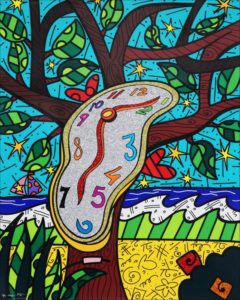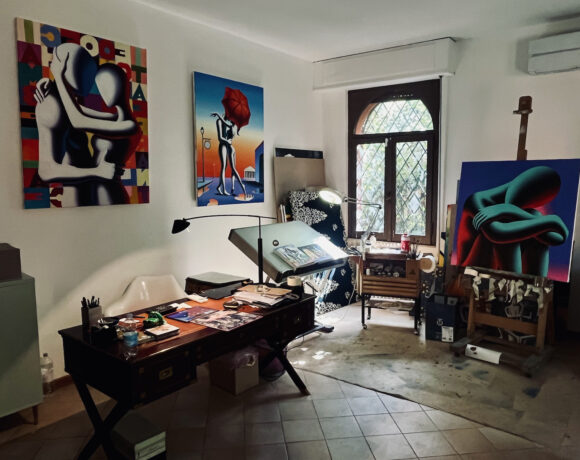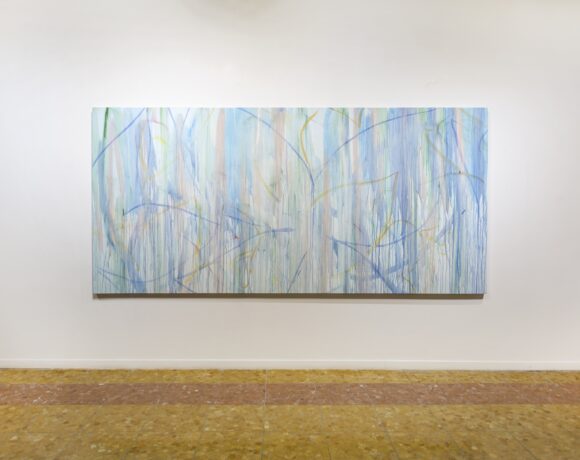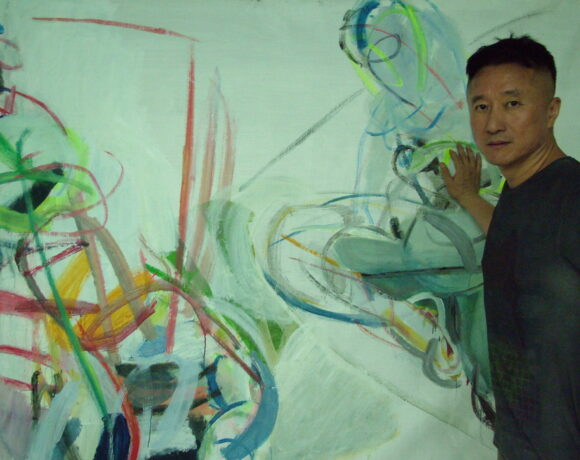Optimism, synergy, liveliness, love, vibrant chromatism, seriality: this is the content and stylistic code of the famous Brazilian pop artist who lives in Miami, Romero Britto, who using a message and a language of universal hope, which especially in a moment like this that is experiencing the whole world is more comforting than ever, proposes an art of disarming naivety, which makes us rediscover children.
Romero Britto began his artistic career as a self-taught by joining the street artists and taking a cue from their forms and their techniques. In this first phase, Romero Britto’s works are made of recycled materials such as newspaper clippings and pieces of cardboard. But it is with the trip to Paris that the artist, known internationally today, began to identify himself through his unmistakable style. The encounter with the works of masters such as Matisse and Picasso, allowed Britto to customize his technique.
Britto’s works have been exhibited in galleries and museums in over 100 countries, including the exhibition on the occasion of the Salon de la Société National des Beaux Arts at the Carrousel du Louvre in 2008 and 2010. In 2013 Romero Britto was the living first artist to exhibit at the Soumaya Museum in Mexico City. He has created numerous public art installations, among which stands out the sculpture for London’s Hyde Park, the largest in the history of the park; he was the official artist for the 2010 World Cup and ambassador for the 2014 FIFA World Cup in Brazil.
Similar to Roy Linchtenstein and Keith Haring who surround the figures with a thick and black stroke, the art of Romero Britto tends to the simplification that refers to cubism and street art, and to reductionism and repetition of the figures. But what has decreed the extraordinary success of the art of Britto? The immediate recognition and identification by those who observe his works, of great visual impact and obviously an important standardization and marketing, supported by the presence of a strong speech, a slogan that reaches everyone. Britto is an open but at the same time responsible art.
Smiles, puppies, joyful faces populate the works of Britto whose monotony has become style, market style, trademark and synonym of success. Britto is a color poet, not a storyteller, he is interested in thrilling and cheering the visitor of one of his shows or the buyer of one of his works here and now.
Without a doubt Romero Britto is a skilled entrepreneur of himself but his tendency to detach himself from certain nihilistic and obscene approaches of contemporary art that tries to represent the invisible affects him. Britto shows us a piece of the world that we often wind up or ridicule; tells us that art is not only the thing that uncovers the pieces of the world unnoticed around us, but also illuminates the darkness that is within us, showing something known as if it were the first time you saw it, as it can be a heart. Isn’t the aim of art also to give us a feeling of the thing, a feeling that must be vision, and not just recognition? Romero Britto changes the lenses of our glasses to make us discover what we see daily.
How do you explain your extraordinary success?
I think success is what we do, because what I like and what makes me wake up in the morning and come to my studio and create images. It’s something I have in common with the rest of the world. We all want to be fine. You all want to be respected. We want to feel like we are all worthy of living and that we are here for something. So I think when I come to my art, I come to my studio to do these things. And I put all this in my work. People see it and react to it. And then basically they feel something in my work that I inserted, I guess that’s why people interact with my works. That’s why my success is due to the fact that people feel that mine is art.
What do you think and hope that people have understood more about your art?
I think most people understand that it doesn’t matter where you come from, what religion, what cultural background you have, it always matters that you want to be loved and to love, and you want to express it in a way. I wish there was a small majority of people, for whom love, understanding and compassion are not priorities in their lives, who understand that love is all I care about.
Can pop art also be “introspective”?
I think we can be different things, different times of the day. Sometimes we can be very outgoing, very introspective. Sometimes we can be very clear. Sometimes we may not be so clear. Everything is often confused and chaotic. There seems to be nothing stable. We are fragile and vulnerable.
Do you remember your first artwork?
I remember many works, but not exactly the first piece of art. I remember the first piece of art I saw. The first piece of art I created as a child was a long time ago.
What do you think of serial advertising? Don’t you think that the branding of a work of art is in a certain sense “humiliating” for the uniqueness of the work itself?
I think then we will definitely have to adapt to the changes. And I believe that a work of art should be on the front page in newspapers like the main news or appear on TV in the early evening, but, unfortunately, this does not happen. So I say for sure: don’t see it as a bad thing!
Andy Warhol said that pop art is a way of loving things. Do you Agree?
Yes, it is an interesting point of view and it makes sense, the masses, the people in the streets, at home and in groups, love certain things because they express themselves. People love recyclability and seriality and want it to reproduce and repeat continuously.
The most brilliant and rewarding moment of your career?
There are still many moments in my career that I love and that amuse me, I know so many moments from now, having my huge sculpture in Hyde Park, the largest artistic installation in the history of the park. So it was really special to have public sculpture there in London. And then the taxis with my art on them. It was a really exciting moment for me. You know, it’s like having past and future coming together in the same place. It was really cool. There are so many moments. It is really difficult to explain. I was very lucky because I have many beautiful memories in London.
Your art conveys positivity, cheerfulness, optimism. Is it his nature, your will to transmit joyful messages? And how would you describe the global health emergency we are experiencing?
Sure, I’m optimistic. Unfortunately, there are so many things along the way that make our lives a little more demanding. We beings are united by our cultural and educational differences, aspects that make us who we are and have led us to where we are today and we leave the way we live today. So we have to deal with this and understand what’s going on, then take care of ourselves and make sure the safety of our world.
You are Brazilian and you work in Miami, is there a different conception of art between Brazil and the United States?
I think art is art everywhere. I think that at the end of the day, the public is present in the art. There is a universal and some artists can only explain something that only a village can understand or a certain group of people. So I think this is the challenge. A lot of time for an audience that is trying to say something that only someone in Brazil could understand or in Texas. But when you have a more universal veil, it is much easier for you to spread your message.
What do you think of Italian art? Which artists do you appreciate most?
I have so many Italian artists in mind that I love, starting with the great masters of the past such as Michelangelo. I mean that there are so many Italian artists who over the years have made such a great contribution to art. Italy is rich in culture. The Deodato gallery is selling my work in Italy and every time someone from Italy buys one of my works, I feel very proud and honored because it is as if there was a piece of my art every day in the lives of people in Italy.
When you are about to design and build a work, do you immediately think of its marketability?
No, when I create a work of art, I’m definitely not thinking about what will come next. I can’t know, I’m not calculating anything. But I was very lucky that people really like and enjoy my art and we share it in the world.
The funniest artwork commissioned to you?
The funniest job I have been commissioned … I would say it was also the most flop: when I made a speech with the dress of Dolce Gabbana for a fashion show. It was very funny.
What are you working on now? Can you anticipate something?
I am working on many projects. So many, from digital, to projects for television to cartoons, passing through fashion. It happens so much in my studio every day.
Info:
 Romero Britto in his studio
Romero Britto in his studio
 Romero Britto, Couples and music, digital screen printing on canvas, 101×76 cm
Romero Britto, Couples and music, digital screen printing on canvas, 101×76 cm
![]() Romero Britto, Dutch icon, digital screen printing, 76x101cm
Romero Britto, Dutch icon, digital screen printing, 76x101cm
 Romero Britto, Flying love, 2007, acrylic on canvas, 48×60 cm
Romero Britto, Flying love, 2007, acrylic on canvas, 48×60 cm
 Romero Britto, Timeless, digital screen printing on canvas, 2019, 121×152 cm
Romero Britto, Timeless, digital screen printing on canvas, 2019, 121×152 cm
Journalist, blogger and social media editor from Campania. i graduated in literature and philology and I gained a master in art and organization of cultural events. I love cinema, art, music, literature, especially Russian, French and Italian. I read a lot, both narrative and non-fiction. I share Picasso’s thoughts on art: “Art helps us to recognize the truth”.






NO COMMENT